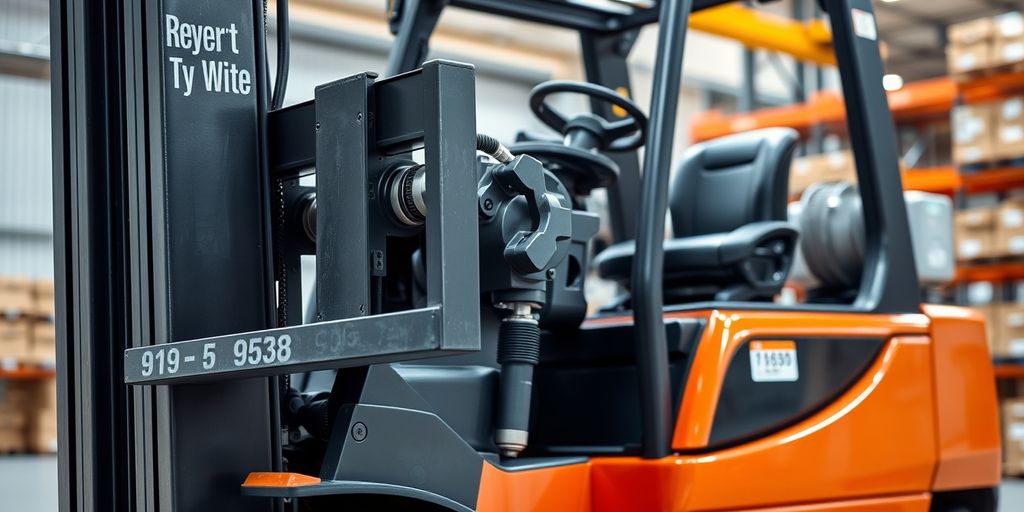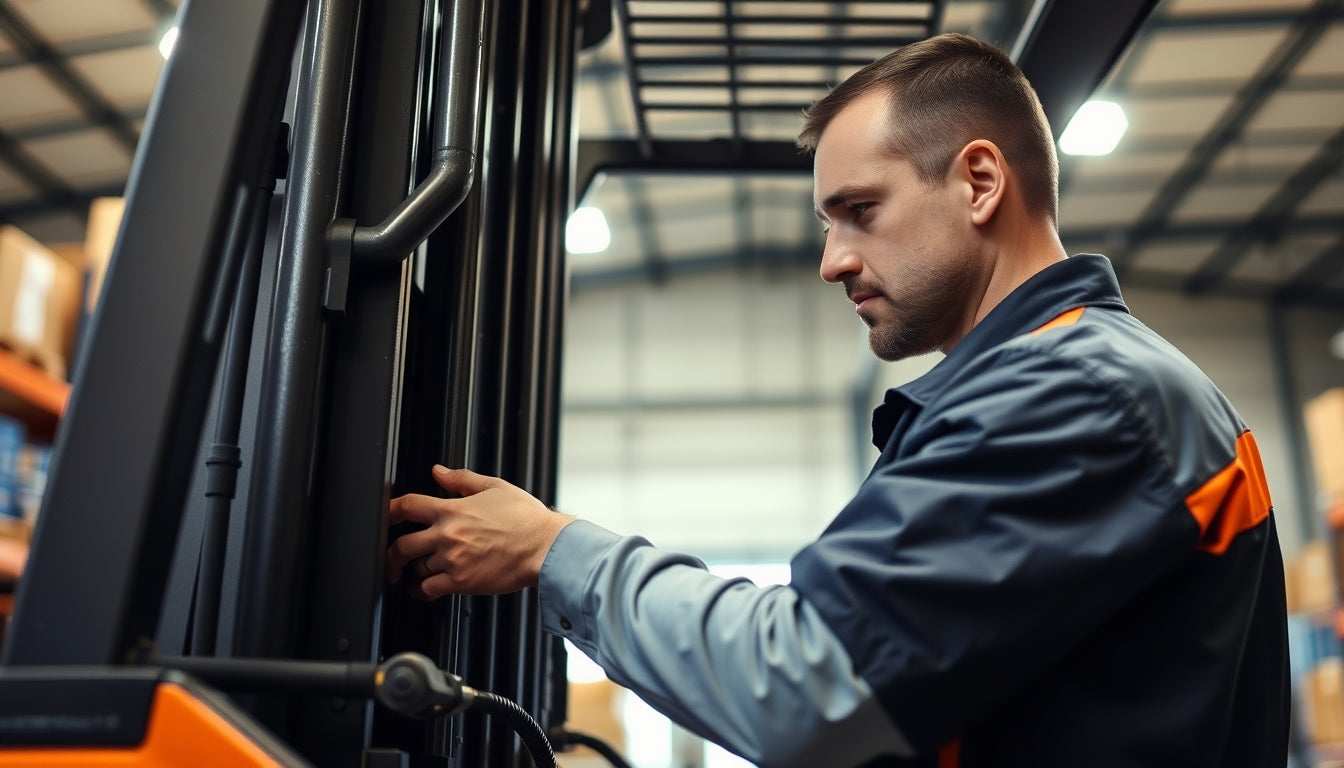Hydraulic systems are the heart of forklifts, powering their ability to lift and move heavy loads. With advancements in technology, these systems have become more efficient and reliable. This article explores the latest innovations in hydraulic systems for forklifts and how they enhance performance and safety.
Key Takeaways
- Hydraulic systems are crucial for the lifting and moving capabilities of forklifts.
- Advancements like electronic control systems and smart sensors improve performance and safety.
- Regular maintenance, including fluid checks and part replacements, is essential for optimal operation.
- Proper operator training on hydraulic controls and safety practices boosts efficiency and reduces wear.
- Emerging trends such as autonomous forklifts and sustainable hydraulic solutions are shaping the future of the industry.
Advancements in Hydraulic Control Systems

Electronic Control Systems
The integration of electronic control systems in hydraulic technology has revolutionized the industry. These systems offer precise control over hydraulic functions, enhancing both performance and safety. By using software, operators can now adjust parameters quickly, eliminating the need for hardware changes. This flexibility simplifies machine development and commissioning, making it easier to achieve desired outcomes.
Smart Sensors Integration
Smart sensors have become a game-changer in hydraulic systems. These sensors provide real-time data on various parameters, such as pressure and temperature, allowing for immediate adjustments. This not only improves efficiency but also helps in predictive maintenance, reducing downtime and extending the lifespan of hydraulic components.
Proportional Valves
Proportional valves are another significant advancement in hydraulic control systems. These valves allow for variable control of hydraulic fluid flow, offering more precise and smooth operation. They are particularly useful in applications requiring fine adjustments, such as in material handling and industrial automation.
The integration of these advanced technologies has made hydraulic systems more reliable and efficient, meeting the ever-evolving needs of various industries.
Maintenance Strategies for Hydraulic Systems
Scheduled Inspections
Regular inspections are essential to keep hydraulic systems in top shape. Routine checks help spot wear, leaks, or damage early. Inspect hoses, fittings, seals, and connections for any issues. Pay attention to fluid levels and cleanliness, and listen for unusual noises or vibrations during operation.
Fluid Checks and Replacements
Proper fluid maintenance is crucial for hydraulic systems to work well. Follow guidelines for fluid selection, viscosity, and change intervals. Regularly monitor fluid quality and cleanliness, and perform fluid analysis to detect any contamination or degradation.
Component Preventive Replacements
Preventive replacement of components can save time and money in the long run. Regularly inspect and replace seals to prevent leaks and ensure system integrity. Use high-quality filters to keep the hydraulic fluid clean and free from debris, water, and air contaminants. Replace filters as needed to maintain optimal filtration efficiency.
By following these maintenance strategies, operators can ensure the longevity and optimal performance of their hydraulic systems. Regular maintenance, coupled with proper fluid management and contamination control, will help maximize efficiency, minimize downtime, and extend the lifespan of the hydraulic equipment.
Operator Training for Optimal Hydraulic Performance
Hydraulic Controls Training
Proper training on hydraulic controls is essential for forklift operators. [Certified training programs](https://onlineoshasafetytraining.com/driving-a-forklift-for-the-first-time/) ensure that operators understand how to use the controls effectively, which helps in achieving optimal operating temperature for the engine and hydraulic systems. This training often includes hands-on practice and theoretical knowledge, covering various aspects of hydraulic operations.
Load Capacity Considerations
Understanding load capacity is crucial for safe and efficient forklift operation. Operators must be trained to recognize the limits of their equipment and how to handle different loads. This knowledge helps in preventing accidents and ensuring that the forklift remains free from movement during major changes in load elevations. Training programs often include guidelines on how to distribute weight and manage load stability.
Safe Operating Practices
Safety is a top priority when operating forklifts. Training programs emphasize the importance of safe operating practices to minimize risks. Operators learn about the potential hazards and how to avoid them. This includes understanding the importance of regular maintenance checks, proper use of safety features, and adherence to operational protocols. Safe operating practices not only protect the operator but also enhance the overall reliability of the hydraulic system.
Proper operator training ensures that hydraulic functions are utilized effectively, minimizing wear on components and optimizing energy consumption.
Key Hydraulic Components and Their Roles
Hydraulic Cylinders
The lifting mechanism of a forklift relies on hydraulic cylinders to convert hydraulic pressure into mechanical force. These cylinders, often equipped with a piston and rod assembly, extend or retract to lift or lower the forks. The design and quality of hydraulic cylinders significantly impact lifting precision and overall performance. Double-acting cylinders, capable of exerting force in both directions, are commonly used in forklifts for enhanced versatility.
Seals and Leak Prevention
In the hydraulic realm, seals act as silent guardians, preventing the unwanted escape of hydraulic fluid and maintaining the system’s integrity. Forklift hydraulic systems employ various seals, including O-rings, gaskets, and lip seals, strategically placed at joints and connection points. Regular inspection and replacement of these seals are essential to prevent leaks, which can compromise performance and lead to costly repairs.
Hydraulic Filters
Cleanliness is paramount in a hydraulic system, and filters play a crucial role in maintaining the purity of the hydraulic fluid. Hydraulic filters trap contaminants such as dirt, debris, and metal particles, preventing them from circulating through the system and causing damage. Routine filter maintenance is vital to ensure optimal performance and longevity of forklift hydraulic components.
Efficiency and Integration of Hydraulic Systems
Component Integration
The efficiency of hydraulic systems in forklifts is greatly influenced by how well the components are integrated. Proper integration ensures that each part works seamlessly with the others, leading to better performance and reliability. This integration directly affects the forklift’s overall performance, including lifting speed, precision, and energy consumption.
Energy Consumption Optimization
Energy efficiency is a key focus in the hydraulic equipment market. Manufacturers are developing systems that minimize energy losses and incorporate regenerative technologies. These energy-efficient systems help reduce operational costs and support sustainability efforts. The main issue with hydraulic equipment is its high energy consumption, which can lead to increased costs. By optimizing energy use, these systems can become more cost-effective and environmentally friendly.
Lifting Speed and Precision
Advancements in hydraulic technology have led to significant improvements in lifting speed and precision. Innovations such as electronic control systems and smart sensors provide operators with greater control and real-time monitoring of hydraulic functions. These advancements not only improve efficiency but also contribute to the safety and reliability of forklift operations.
In the dynamic world of material handling, forklifts stand as indispensable tools, and their hydraulic systems serve as the powerhouse behind their lifting capabilities. The marriage of precision engineering, advanced technology, and meticulous maintenance ensures that forklift hydraulic systems operate seamlessly, delivering the pumping power needed to elevate industries, one load at a time.
Emerging Trends in Forklift Hydraulics

Autonomous Forklifts
The shift towards autonomous forklifts is transforming the industry. These machines can navigate warehouses with minimal human intervention, reducing accidents and boosting efficiency. Advanced display modules provide real-time data, enhancing control and reliability in complex environments.
Sustainable Hydraulic Solutions
Environmental concerns are driving the adoption of sustainable hydraulic solutions. Electric forklifts and hydrogen fuel cells are becoming more popular due to their zero emissions and quick refueling times. This shift not only addresses environmental issues but also meets the operational needs of modern warehouses.
AI and IoT Integration
The integration of AI and IoT in forklifts is revolutionizing the industry. These technologies enable predictive maintenance, autonomous navigation, and adaptive load handling. AI-driven forklifts enhance efficiency and safety, making them a key trend in the evolution of forklift technology.
Hydraulic Fluid Dynamics
Role of Hydraulic Fluid
Hydraulic fluid, often hydraulic oil, is the lifeblood of a forklift's hydraulic system. It transmits force, lubricates moving parts, and reduces wear and tear. The fluid is pressurized by a hydraulic pump, creating a force that pushes against the surfaces of hydraulic cylinders or pistons. This process enables accurate and strong lifting operations.
Fluid Selection Criteria
Choosing the right hydraulic fluid is crucial. It must withstand high pressures and temperature variations while providing adequate lubrication. Here are some key factors to consider:
- Viscosity: The fluid should have the right thickness to flow easily but still provide enough lubrication.
- Temperature Range: It should perform well under the operating temperatures of the forklift.
- Compatibility: The fluid must be compatible with the materials used in the hydraulic system.
Custom-Made Hydraulic Components
Integrating custom-made components, such as made-to-order hydraulic hoses and other precisely engineered parts, significantly enhances the system’s safety and efficiency. These bespoke parts are tailored to meet your machinery’s exact specifications and tolerances, ensuring a perfect fit that reduces the risk of leaks and mechanical failures.
Regular maintenance, including fluid checks and replacements, is vital to keep the hydraulic system in optimal condition, ensuring that every component, whether standard or custom-made, functions seamlessly together.
Conclusion
In the fast-paced world of material handling, forklifts are essential tools, and their hydraulic systems are the heart of their performance. Recent innovations, such as smart sensors and electronic controls, have significantly improved the efficiency and safety of these machines. Regular maintenance and proper operator training are crucial to keep these systems running smoothly and safely. As technology continues to advance, we can expect even more improvements in hydraulic systems, making forklifts more reliable and efficient. By embracing these innovations, businesses can ensure their operations remain competitive and productive.
Frequently Asked Questions
What are the benefits of electronic control systems in forklifts?
Electronic control systems enhance the performance of forklifts by providing operators with better control and real-time monitoring of hydraulic functions. This leads to improved efficiency, safety, and reliability.
How often should hydraulic fluid be checked and replaced in forklifts?
Hydraulic fluid should be checked regularly and replaced according to the manufacturer's recommendations. Regular checks help maintain optimal performance and prevent potential damage to the hydraulic system.
Why is operator training important for forklift hydraulic systems?
Proper operator training ensures that hydraulic functions are used effectively, reducing wear on components and optimizing energy use. Training also covers load capacity and safe operating practices, which are crucial for safety and efficiency.
What role do hydraulic cylinders play in forklifts?
Hydraulic cylinders convert hydraulic pressure into mechanical force, allowing the forklift to lift and lower loads. The quality and design of these cylinders are vital for precise lifting and overall performance.
What advancements are being made in sustainable hydraulic solutions for forklifts?
Advancements in sustainable hydraulic solutions include the development of electric and hydrogen fuel cell forklifts. These technologies aim to reduce emissions and improve energy efficiency, contributing to environmental sustainability.
How do smart sensors improve forklift hydraulic systems?
Smart sensors provide real-time data on hydraulic system performance, helping to monitor and adjust operations for better efficiency and safety. They can detect issues early, reducing the risk of breakdowns and improving overall reliability.




Leave a comment
This site is protected by hCaptcha and the hCaptcha Privacy Policy and Terms of Service apply.